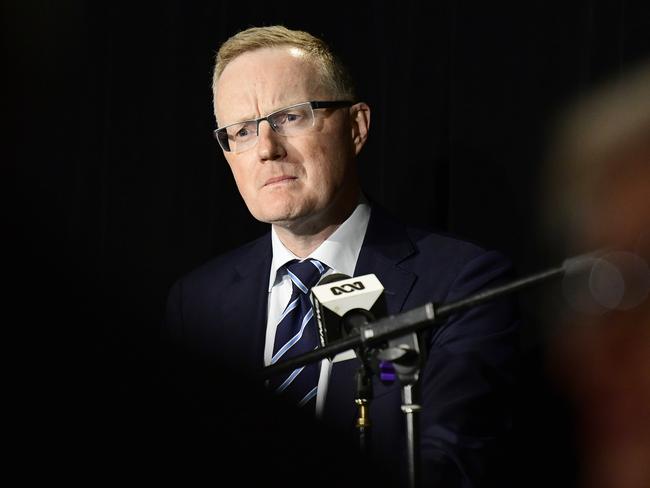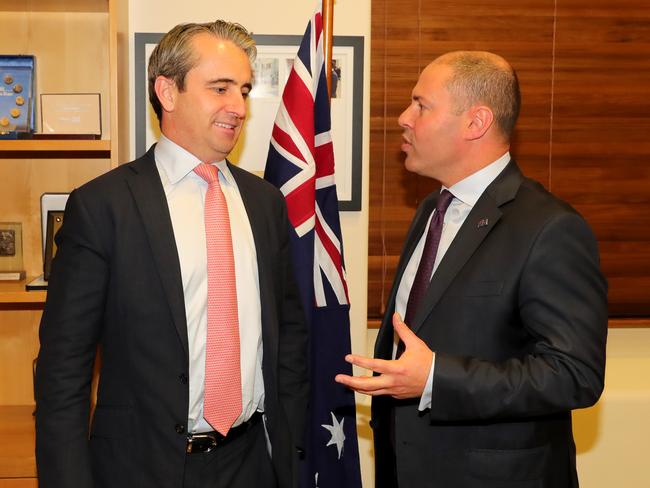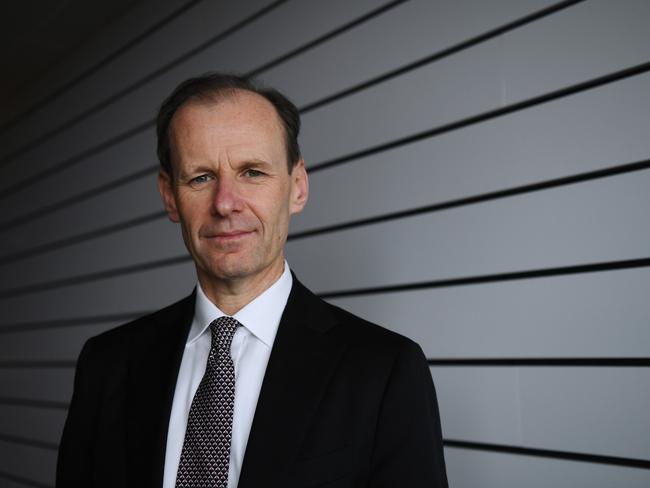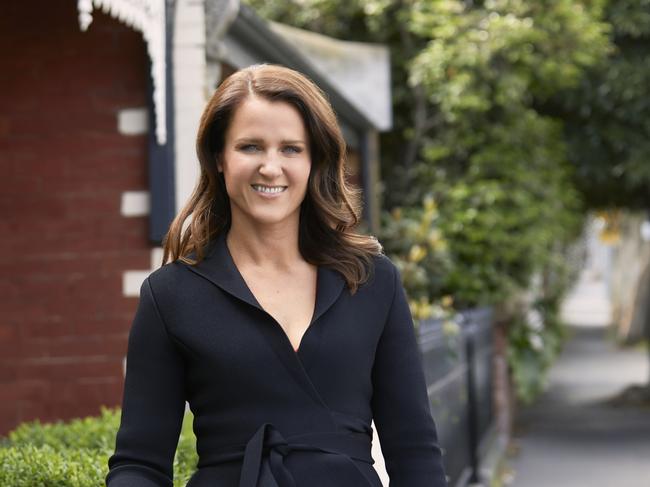What the Reserve Bank interest rate cut will mean for you
Breaking with tradition, the governor of the Reserve Bank has publicly challenged Westpac and ANZ for refusing to pass on all of its interest rate cut.
The governor of Australia’s Reserve Bank has added his voice to growing criticism of Westpac and ANZ — saying the banks must explain why they have kept some of the money for themselves despite falling costs.
The Australian reports Philip Lowe last night demanded that banks pass on the full cut in the official interest rate to help drive economic growth.
Dr Lowe said bank funding costs had fallen to 2017 levels, and the banks had last year raised mortgage rates by an average 15 basis points on their own accord.
Breaking with the RBA’s practice of not commenting on rate movements, Dr Lowe said: “This reduction in the cash rate should be fully passed through to variable mortgage rates. Full pass-through would also mean that the economy receives the full benefit of today’s policy decision.”
Treasurer pressures banks to pass on full rate cut
The cash rate was dropped by 25 basis points to 1.25 per cent yesterday, marking the first cut in nearly three years, with more expected to follow.
But the ANZ said it would cut variable mortgage rates by just 18 basis points. Westpac later announced it would cut its standard rate by only 20 basis points.
National Australia Bank and Commonwealth passed on the RBA’s cut in full — saving the average borrower $62 a month, or $744 a year, on the average $400,000 mortgage.
TROUBLING DATA
National accounts data — a measure of the strength of the economy — to be released today is expected to show growth remained soft in the March quarter.
The market consensus forecast is for anaemic gross domestic product growth of 0.4 per cent in the quarter and 1.8 per centannually.
Mr Frydenberg insists the “fundamentals” of the economy are sound and is confident it will continue to grow at 2.75 per centfor 2019 and 2020, despite headwinds.
“We are facing economic challenges both domestically and internationally, particularly from the trade tensions between Chinaand the US.”
But Opposition treasury spokesman Jim Chalmers argues the Reserve Bank’s need to cut the interest rate and the likely weak figures show the economy isn’t in good hands.
“It’s not enough to pretend that you’re good economic managers,” he said.

The RBA’s Dr Lowe also expressed caution about the economy’s prospects, saying flat wages and falling house prices was producing enough uncertainty to warrant future rate cuts.
“The economic outlook remains reasonable, with the main downside risk being the international trade disputes, which have intensified recently,” he added.
“It is possible that the current policy settings will be enough — that we just need to be patient. But it is also possible that the current policy settings will leave us short. Given this, the possibility of lower interest rates remains on the table.”

CUSTOMERS ‘LET DOWN’
Treasurer Josh Frydenberg has said the banks owe their customers an explanation.
The rate reflects what the central bank charges commercial banks on overnight loans, and therefore influences other interest rates.
The central bank’s cut is intended to encourage borrowing and investing, ultimately stirring economic growth by helping more Australians find jobs and controlling inflation.
There is no reason why Westpac and ANZ couldn’t have passed all of the cut on, Mr Frydenberg believes.
“I think their customers have been let down by this decision,” he told Nine’s Today program this morning.
“We know that people can move between banks and seek a better deal as well, and I’d encourage them to always look for the best possible deal for themselves and for their families and their businesses.”
Mr Frydenberg says he can’t force the banks’ hand but has reminded them of the recent damning financial services royal commission.
“Here was an opportunity, post the royal commission, to do the right thing by your customers,” he told ABC Radio National.
Shadow treasurer Jim Chalmers says Westpac and ANZ’s choice not to do the same is “disgraceful”, as the nation grapples with a slowing economy.
“We can’t afford to have banks pocket some of this interest rate relief,” he told ABC News this morning.
Mr Chalmers has also reminded customers they can express their distaste by going elsewhere if they’d like.
“They should certainly shop around to see whether they can get a better deal somewhere else.”

ANZ OFFERS EXCUSE
ANZ Australia retail and commercial group executive Mark Hand said the bank had “weighed up” a number of factors in making the decision, including business performance, market conditions and the impact on depositors.
“While we recognise some home loan customers will be disappointed, in making this decision we have needed to balance the increased cost in managing our business with our desire to provide customers with the most competitive lending and deposit rates possible,” Mr Hand said.
“Home loan customers looking for certainty with their repayments can look to lock in our historic low fixed rate home loans for our two and three year terms.”
The decision by ANZ to keep some of the cut comes despite federal treasurer Josh Frydenberg urging the banks to pass any cut in full prior to today’s RBA board meeting.
The Reserve Bank has finally cut interest rates to a new historic low, breaking its longest ever streak without a change.
The move comes after Treasurer Josh Frydenberg met with bank bosses yesterday to encourage them to pass on the rate cut in full, to help stimulate the economy.

TOUGH TIMES AHEAD
Economists predicted the RBA rate cut at its monthly board meeting on Tuesday. Many expect a second rate cut in August, and some expect more.
Many economists, including those at Westpac, ANZ and JP Morgan, expect at least one more 25 basis point cut to be delivered by November.
It is the first time the cash rate has moved under RBA governor Philip Lowe who took over the role in September 2016.
Prior to today’s meeting the RBA had held the cash rate steady for 33 consecutive months.
The new cut, combined with another likely cut soon and recent regulator moves to help with mortgage serviceability, will dramatically boost households’ borrowing power.
Research group Canstar has found an average wage earner would be able to borrow an extra $32,000 — up from $363,000 to 395,000 — if the changes go through as expected.
Banking regulator APRA currently requires banks to base borrowers’ mortgage serviceability stress tests on an interest rate of around 7.25 per cent, but has proposed that this change to 2.5 per cent above the standard variable rate.
Canstar’s Mr Mickenbecker said the move would “add a lot of borrowing power”.
“Given that prices have come down, it means more people will qualify for a loan that they previously could not have qualified for,” he said.
Big questions are now facing households. Why are interest rates falling? How low will they go? Should borrowers fix or stick with variable rates?

But the most pressing question is whether banks will pass on the full rate cut to borrowers, after pocketing more than 1 per cent of the 3.25 per cent of RBA rate cuts since 2011.
Realestate.com.au chief economist Nerida Conisbee said there had not been an RBA rate cut since 2016 and there was an expectation that the full 0.25 per cent cut would be passed on.
“People are feeling pretty negative towards the banks after the royal commission,” she said, adding that banks would want to “improve consumer sentiment towards them”.
AMP Capital chief economist Shane Oliver also believes banks will pass on all or most of the RBA cut to customers, but RateCity research director Sally Tindall isn’t so sure.
“The last time the RBA cut rates the big banks passed on just under half,” Ms Tindall said. “I’m not expecting them to pass it on in full.”
Tuesday’s decision is the start of a fresh period of interest rate action, so here’s what consumers need to know.
WHY THE CUTS?
The RBA uses interest rates as a lever to keep the economy growing steadily.
It says a two to three per cent range for Consumer Price Index inflation is ideal to “encourage strong and sustainable growth in the economy”.
Rate rises are designed to put the brakes on inflation while rate cuts are like an accelerator.

Annual inflation is running at 1.3 per cent despite record low interest rates and Ms Tindall said this, combined with rising unemployment and weak wages growth, created a trifecta that needed to be fixed.
“They have got to act to get out of this, and need to inject some life into the economy,” she said.
The RBA has delivered 13 straight cuts — including a 50 basis point cut in May 2012 — since November 2011.
The downward trend has taken the nation’s official cash rate from 4.75 per cent to its new low of 1.25 per cent.
The cash rate was last raised in November 2010.
HOW MUCH WILL THEY FALL?
Most economists expected the official cash rate to drop from 1.5 per cent to 1.25 per cent today, and then to 1 per cent in August.
Some — including Westpac’s Bill Evans — predict three cuts by November.
Two RBA cuts means average mortgage customers are likely to save at least $100 a month on their repayments.
“It will be common for us to see home loan rates with a “2” in front of them by the end of this year,” Ms Tindall said.
Greater Bank became the nation’s first bank to do this last week when it announced a one-year fixed rate of 2.99 per cent.

WINNERS AND LOSERS
People with variable rate mortgages — particularly new home loan customers — are the biggest winners from a rate cuts, which lower their cost of borrowing.
On the flip side, those saving for a new home will receive a paltry return on their bank deposits, while retirees who rely on cash in the bank will also suffer.
IMPACT ON HOUSING
Ms Conisbee said the rate cut would have a positive effect on the housing market, with history showing that cuts had an immediate effect on search activity on realestate.com.au.
“It gives people more money to buy and more confidence in the market,” she said.
A rate cut, combined with regulator plans to soften borrowing rules and Labor’s election loss spelling the end of negative gearing tax changes, would be “enough to stop the fall in prices we have seen”.

Landlords, with extra cash in their pockets and no worries about tough new taxes, are unlikely to raise rents sharply as was feared under a potential Labor government.
Dr Oliver said low interest rates would help the national housing downturn bottom out and “next year I would assume pretty flat property prices”.
“I don’t think it will set off another housing boom because household debt is much higher than when they started cutting rates in 2011,” he said.
FIXED OR VARIABLE?
RateCity’s Ms Tindall said deciding whether to choose a fixed or variable rate loan depended on personal preferences.
“Do you like the idea of knowing exactly how much your fixed repayments will be?” she said.
“With fixed rates you may miss out on another RBA rate cut or two, but if you don’t fix you may be subjected to out-of-cycle rate hikes by your bank.”
Borrowers can also choose a part-fixed, part-variable loan.
InfoChoice CEO Vadim Taube said borrowers could organise a large interest rate cut for themselves just by comparing their own mortgage rate with the best rates now in the market.
“Many borrowers are now paying 4.5 per cent plus on their home loan,” he said.
“By refinancing to a loan around 3.5 per cent a borrower would be give themselves the equivalent of four RBA rate cuts of 0.25 percentage points each.”
SEVEN TIPS IF YOU HAVE A RATE CUT
*Take a deep breath. There’s no need to rush any decisions because more rate cuts are likely.
*Find out what mortgage interest rate you are paying.
*If it’s more than 4 per cent for an owner-occupier principal and interest loan, seek a better deal.
*Research other banks’ mortgage rates using online comparison websites or phone calls.
*Banks offer new customers better rates so ask your lender to match or beat that rate.
*Consider speaking with a mortgage broker who can find good home loan deals.
*RateCity says: “Now is an excellent time to have the discussion because banks are desperate for new customers. Turn yourself from an existing customer into a new one.”
Originally published as What the Reserve Bank interest rate cut will mean for you


